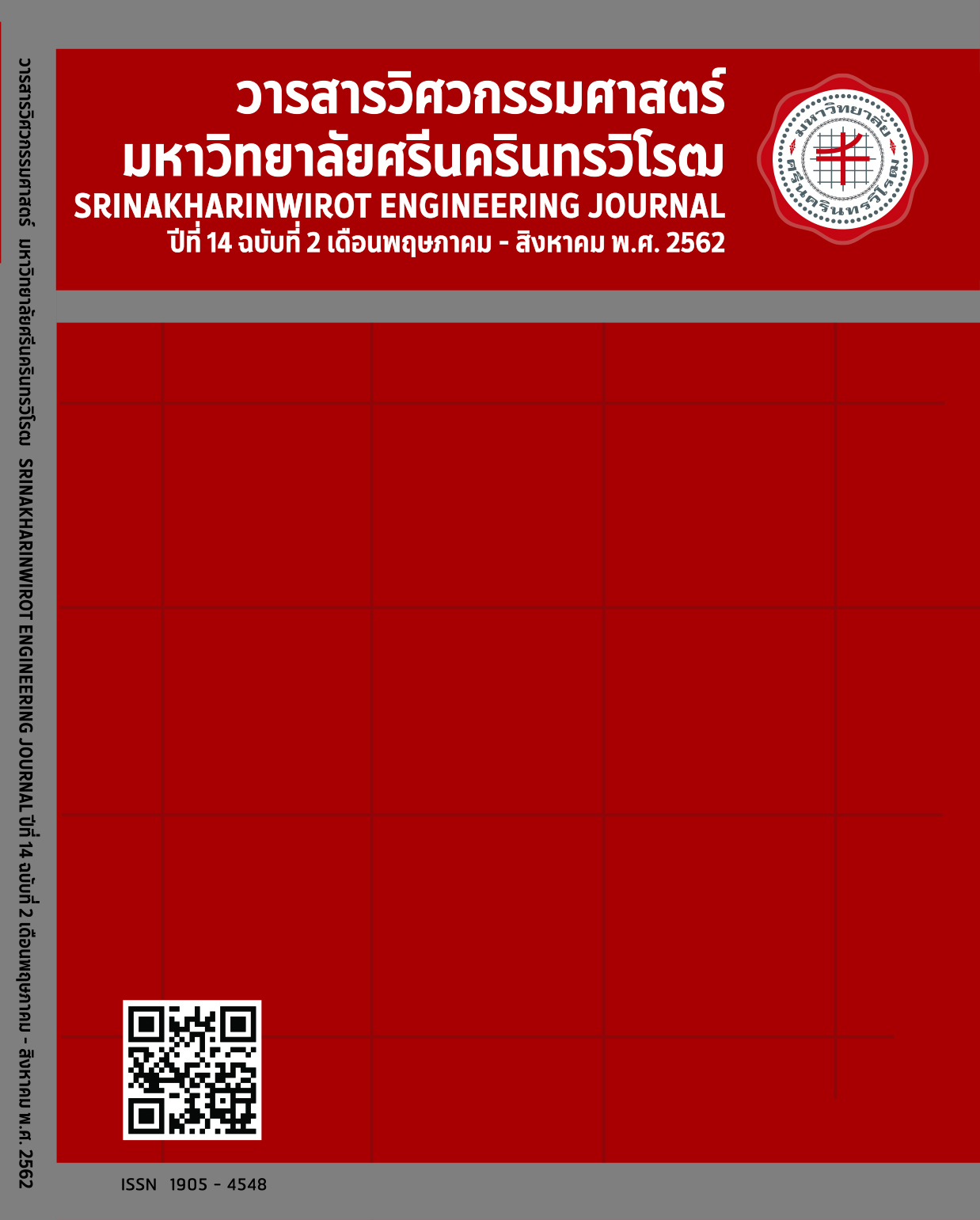Water Quality Assessment of Right Main Canal in Nakhon Nayok Province
Main Article Content
Abstract
This research was to investigate the quality of water in the water transmission right main canal in Nakhon Nayok province. There were 8 sampling points along the water route. Samples were taken from January 2019 to March 2019. The results shown that the right main canal is a canal which receives water from the Nakhon Nayok River for agriculture, consumption which used to produce tap water in Ban Na District and Ongkharak District. The land use nearby the right main canal is divided into 3 parts: land use for agriculture, accommodation and other activities, such as, restaurants. The results of measuring the water quality were found different in each points depending on the source of pollution from land use along the canal. In the sampling point No.6, 7 and 8 were found the total water quality including BOD, SS, NH3-N, PO43-, TCB and FCB were higher than other points. According to DO was low. That caused by the release of contaminated water from household and human feces into the canal. The results of the water quality assessment was found the water quality index (WQI) was in the range of 55 - 71. At the sampling point No.1 to No.5, the surface water quality assessment results were moderate to good which could be compared with the water quality standard class 2-3. At the sampling point No.6 to No.8, the surface water quality assessment results were deteriorated which could be compared with surface water quality standard class 4. It could be concluded that the water quality of right main canal depended on the source of pollution. The household wastewater was the main factor affecting the water quality. Because it was contaminated of organic matter and pathogenic bacteria. Therefore, monitoring the environmental health impact should be set as an important policy for this area.
Article Details
Copyright belongs to Srinakharinwirot University Engineering Journal
References
[2] Pollution Control Department Ministry of Natural Resources and Environment, 2019, (10 August 2019), Water quality and management, (in Thai), [online], Available: https://www.pcd.go.th/info_serv/water_savewater.html.
[3] APHA AWWA WEF, 2005, Standard Method for the Examination of Water and Wastewater, 21st ed, American Public Health Association, Washington DC, USA.
[4] Pollution Control Department Ministry of Natural Resources and Environment, 2013, (15 July 2019), Total score of water quality 5 parameters, (in Thai), [online], Available: https://iwis.pcd.go.th/module/wqi_calculate/wqi.pdf.
[5] Ongkharak Subdistrict Municipality. 2561. (10 August 2019), Four years local development plan (2019 - 2022) Ongkharak Subdistrict Municipality, (in Thai), [online]. Available: https://www.ongkarak.go.th/FourYearsLocal.html.
[6] K. Chankaew, “Environmental science,” (in Thai), Aksornsiam printing, Bangkok, 363p. 1988.
[7] Pollution Control Department Ministry of Natural Resources and Environment, 1995, (2 August 2019), Water quality standard, (in Thai), [online]. Available: https://www.pcd.go.th/info_serv/reg_std_water05.html#s3.
[8] N. Niphonkit, “Effects of Land Use Patterns on Surface Water Quality of Middle-Lower Tha-Chin River,” (in Thai), Master of Science thesis, Environmental science, Kasetsart University, Bangkok, 2004.
[9] T. Thongsri, S. Petchkasem, and K. Muang-kaew, “An assessment of coliform and fecal coliform bacteria levels in surface water resources of Bangkok and vicinity area,” (in Thai), Bulletin of Applied Sciences, vol 3, No.3, pp.59-67, 2014.
[10] A. Sangiamjai, “Surface Water Quality arou-nd the Rojana Industrial Park, Phra Nakhon Si Ayutthaya Province,” (in Thai), The Journal of Industrial Technology, vol 15, No.1, pp.1-11, 2019.
[11] N.J. ASHBOLT, O.K. Willie, W. GRABO, and M. SNOZZI. Indicators of microbial water quality. In: Water Quality: Guidelines, Standards and Health. Lorna FEWTRELL and Jamie BARTRAM, eds. London: IWA Publishing, pp. 289-316, 2001.
[12] P. Srisung, N. Moongjomklang, W. Yoochat-chaval, K. Syutsubo, and N. Tomioka, “Central Bangkok canal water quality assessment by molecular technique,” (in Thai), The 23rd National Convention on Civil Engineering, pp. 1-10, 2018.
[13] S. Jaitae, C. Warodomrungsimun, T. Maton, and P. Aungudornpukdee, “Water Quality and Li River Utility, Lumphun Province,” (in Thai), RMUTP Research Journal, vol 9, No.1, pp.112-124, 2015.
[14] S. Thongphrom, and C. Lenthas, “Water Quality Monitoring of Bang Yai Canal in Phuket Province,” (in Thai), Thaksin University Journal, vol 16, No.3, pp.111-119, 2013.


